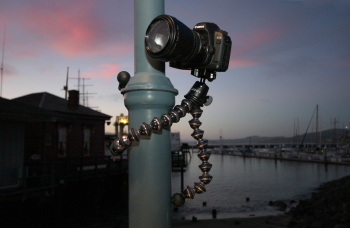Joby Unveils New Gorrillapods at PMA
 Sunday, February 21, 2010 at 3:43PM
Sunday, February 21, 2010 at 3:43PM  Joby, Inc. introduced two new additions to the Gorillapod family of products at this year’s Photo Marketing Association International tradeshow.
Joby, Inc. introduced two new additions to the Gorillapod family of products at this year’s Photo Marketing Association International tradeshow.
REVIEWS
KitchenAid Grain and Rice Cooker
KitchenAid Semi-Automatic Espresso Machine with Milk Frother
Microsoft Surface Headphones 2
Shark UltraCyclone Pet Pro+ Hand Vac
ViewSonic M1+ Mini LED Projector
Dyson Hot+Cool purifying fan and heater
Microsoft Surface Go with LTE Advanced
ViewSonic M1 portable projector
Waze navigation app on Apple CarPlay
Rowenta Intense Air Pure Purifier
Bissell CrossWave PetPro Multi-Surface Cleaner
2018 Hyundai Ioniq Electric Plus PHEV Driver
Dyson Pure Cool HEPA Air Purifier and Fan
Sennheiser Ambeo Smart headset
Acer Windows Mixed Reality Headset and Controller
ScoopFree Original Self Cleaning Litter Box
 Sunday, February 21, 2010 at 3:43PM
Sunday, February 21, 2010 at 3:43PM  Joby, Inc. introduced two new additions to the Gorillapod family of products at this year’s Photo Marketing Association International tradeshow.
Joby, Inc. introduced two new additions to the Gorillapod family of products at this year’s Photo Marketing Association International tradeshow.
 Saturday, February 20, 2010 at 10:19AM
Saturday, February 20, 2010 at 10:19AM  By Gadjo Cardenas Sevilla
By Gadjo Cardenas Sevilla
Disney and Pixar’s animated feature UP proves that a great quest can turn even the most unusual set of characters into intensely engaging heroes.
UP starts by tugging hard at the heartstrings by revealing the bittersweet life story of 78-year-old balloon salesman Carl Fredericksen (voiced by Ed Asner). Carl is introduced as a gruff little old man grieving over his wife’s death while dealing with the threat of being sent away to a senior’s home and losing his beloved old house.
 Saturday, February 20, 2010 at 7:53AM
Saturday, February 20, 2010 at 7:53AM 
 The Mercedes Benz SLS AMG Gullwing was one of the highlights of the 2010 Canadian Auto Show
The Mercedes Benz SLS AMG Gullwing was one of the highlights of the 2010 Canadian Auto Show
We've been covering the Canadian Auto Show in Toronto for years and were sad and a bit disappointed at what we got to see this year, or rather, what we didn't. Past shows were so huge that it could take you a whole day to cover the exhibit spaces in the North and South Toronto Convention Centre and the cavernous Skydome (Rogers Centre).
Well, the Rogers Centre was dropped this year and fewer car companies were represented - a pity, really. A sign of difficult times, I guess.
 Friday, February 19, 2010 at 8:09AM
Friday, February 19, 2010 at 8:09AM  Sony recently unveiled two new Cyber-shot point-and-shoot digital still cameras (models DSC-TX5 and DSC-H55). Slim enough to fit in your pocket or purse at less than an inch thin -- about the size of a deck of cards. Get to know these new cameras after the jump.
Sony recently unveiled two new Cyber-shot point-and-shoot digital still cameras (models DSC-TX5 and DSC-H55). Slim enough to fit in your pocket or purse at less than an inch thin -- about the size of a deck of cards. Get to know these new cameras after the jump.
